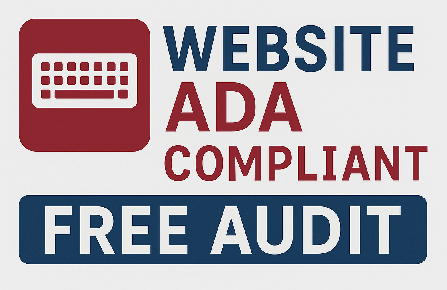See If Your Website Meets DOJ ADA Standards – Free Audit
Here’s what’s really going on behind why some companies get charged or sued over ADA website non-compliance while others don’t.:
⚖️ The ADA law applies broadly — but enforcement is selective
- Under the Americans with Disabilities Act (ADA), Title III, any business that serves the public (retail, services, healthcare, education, etc.) must make its website accessible to people with disabilities.
- However, the Department of Justice (DOJ) does not — and cannot — enforce every violation. There are millions of websites, so the DOJ typically targets larger or high-profile cases that can set an example or establish a legal precedent.

🧑⚖️ Two main sources of action
- DOJ Enforcement Actions:
- These are official investigations or lawsuits brought directly by the DOJ.
- Usually target large corporations, public-facing institutions, or repeat violators.
- The DOJ often settles these with consent decrees, requiring specific accessibility fixes and ongoing monitoring.
- Private Lawsuits:
- Most ADA website cases (over 90%) are actually private civil suits filed by individuals or advocacy law firms.
- These are far more common and typically target small to mid-size businesses that appear noncompliant (no alt text, inaccessible menus, poor contrast, etc.).
- Some law firms are very active in this area, sending hundreds of demand letters monthly.
💡 Why some companies get hit while others don’t
A combination of visibility, risk, and luck:
- High traffic websites attract more scrutiny — both from DOJ and private firms.
- Certain industries are targeted more often — e.g. hospitality, retail, healthcare, finance, and education.
- Public complaints can trigger DOJ investigations.
- Political sensitivity — sites with government contracts or political content may attract more attention.
- Proactive compliance — some companies quietly fix issues before being sued.
📊 4. Real examples
- 2022: Hyatt Hotels settled with DOJ over inaccessible online booking features.
- 2021: Rite Aid was required by DOJ to make its COVID-19 vaccination portal accessible.
- Netflix, Domino’s, and Winn-Dixie — all sued privately, not by DOJ, but the cases set strong precedents that DOJ uses for guidance.
🧩 5. The bottom line
- Every public-facing business website is legally required to be accessible.
- Enforcement is selective but expanding — the DOJ has made it clear it will pursue more web accessibility cases.
- Being proactive (running ADA audits, remediating issues, and documenting efforts) greatly reduces risk — and can serve as a legal defense if challenged.
Here’s an overview of recent Department of Justice (DOJ) actions and trends regarding website accessibility under the Americans with Disabilities Act (ADA):
🏛️ DOJ Enforcement Actions and Regulations
DOJ Enforcement Actions
The DOJ has been actively enforcing ADA compliance through lawsuits and settlement agreements. These actions aim to achieve greater access, inclusion, and equal opportunity for people with disabilities. Specific cases can be found on the DOJ’s Cases page.
New Rule on Web Accessibility for State and Local Governments
On April 24, 2024, the DOJ published a final rule updating its regulations under Title II of the ADA. This rule requires state and local governments to ensure that their websites and mobile applications are accessible to people with disabilities. The rule adopts the Web Content Accessibility Guidelines (WCAG) 2.1 Level AA as the technical standard for compliance. ADA.gov
📊 Trends in ADA Website Accessibility Lawsuits
Number of Lawsuits
In 2024, 1,202 website accessibility lawsuits were filed in the U.S. Notably, 48% of these lawsuits were against companies that had been sued previously, indicating a trend of repeat litigation. Government Information Center
Common Defendants
Lawsuits often target businesses in industries such as hospitality, retail, and healthcare. For instance, the DOJ has taken action against companies like Hyatt Hotels and Rite Aid for ADA non-compliance.
⚖️ Factors Influencing Enforcement
Visibility and Size of the Organization
Larger organizations and those with significant online presence are more likely to be targeted due to their visibility and the broader impact of their compliance.
Industry Type
Certain industries, like hospitality and healthcare, are more frequently targeted due to the nature of their services and the potential impact on individuals with disabilities.
Proactive Compliance Efforts
Organizations that proactively address accessibility issues and demonstrate a commitment to compliance are less likely to face enforcement actions.
🛡️ Mitigating Risks
To reduce the risk of ADA website accessibility lawsuits:
- Conduct Regular Accessibility Audits: Regularly assess your website for compliance with WCAG 2.1 Level AA standards.
- Implement Corrective Measures: Address identified issues promptly to ensure compliance.
- Document Efforts: Keep detailed records of accessibility audits and corrective actions taken.
- Stay Informed: Keep up to date with DOJ regulations and guidelines related to web accessibility.
